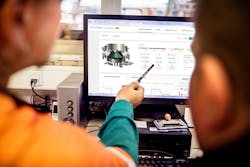Mining is already a highly autonomous industry, with every effort being made to get humans out of dangerous operations. But the vision for 30 years out is an environment that’s considerably more autonomous—machines self-adjusting to minor process variations, pit-to-port optimization and control, all maintenance done on scheduled breaks, with greater than 99 percent availability and uptime of equipment. “We’re not there yet, but it’s something we’re working on,” said Jani Puroranta, chief digital officer for Metso, a Finnish equipment maker big in mining crushers and grinding mills.
Today, much of the focus needs to be on maintenance—how to significantly shift the uptime of machines that have persistently low operating efficiencies. “Whether in Perth or Santiago, there are still dozens of people out there. Why are they there? Because of maintenance; they’re keeping the process running,” Puroranta said. “That’s the thing we need to change.”
At the Automation Fair, Rockwell Automation’s annual event that took place last week in Philadelphia, Metso rolled out new capabilities for its Metso Metrics offering, including a new predictive maintenance solution for mining equipment aimed at maximizing uptime and performance of comminution circuits (where minerals are crushed, ground, cut, etc., into ever smaller pieces).
Mineral processing is a highly variable process, with the bulk of that variability coming from the feed, Puroranta explained. “On the plant side, we need to adjust to that variability,” he said. “We need to take control of that variability, optimize against constraints, get higher throughput and better product.”
Meanwhile, customers are trying to tweak an extra 1-2 percent from that variability, but they’re losing 10-15 percentage points on the availability side, Puroranta added. They need to improve their processes with three levers—reducing process variability, increasing production rate and maximizing asset availability and uptime.
In an industrial world where OEMs are looking to take advantage of digitalization trends to offer more of a service component to their products, Metso is a prominent poster child. The company is leveraging the expertise that machine builders inherently have in their own equipment to create a new business model and provide mining customers with the services they need. In fact, 65 percent of its revenue now comes from servicing, according to Puroranta.
“A lot of equipment builders, like Metso, they understand how their equipment works better than anybody,” noted Sujeet Chand, senior vice president and CTO for Rockwell Automation, during the opening presentation of the Mining Forum at Automation Fair. “They can encode some of those insights in the machine and provide monitoring in the cloud.”
Metso Metrics, an Industrial Internet of Things (IIoT) offering built on Rockwell’s FactoryTalk Cloud platform, is designed to give mines more visibility into their equipment and processes with analytics, condition monitoring and predictive maintenance. It combines data from hundreds of sensors within Metso equipment with support from Metso experts to assess process performance and predict component wear and failure. Metso performance teams analyze the data with the support of advanced machine learning algorithms to help customers optimize equipment operations and processes.
In an operator-centric environment, operators control the feeder speed, monitor product size and execute gap adjustments, and monitor indications of degrading machine health. All of this can and should be automated, Puroranta argued.
Advanced process control (APC) is a well-established way to optimize the process all the way from the crushing stage to thickeners and even smelters, and it’s the foundation for everything to come. Predictive maintenance, Puroranta noted, requires new technologies on top of the APC, including an analytics cloud, pulling relevant data out of their silos and collaborating on shared data.
“Mines are storing a vast amount of data in historians,” Puroranta said. “Some companies make reports, but those reports mostly go unused. We as the OEM can make sense of that data, turn it into action that’s actually useful for the customer. To do this, we need to share data, pull it into the cloud.”
Metso Metric draws on data that already exists. “It’s somewhere in the plant, but nobody uses it,” Puroranta said. “We take that data and make some use out of it.”
The first generation of Metso Metrics tools was launched in 2017 to help optimize aggregates production in quarries and at contractor sites. Metso has also developed a similar solution for waste recycling equipment. Over the past year, Metso has been piloting the latest version of Metso Metrics at five customer sites around the world. By the end of 2019, they hope to have more than 100 assets online.
Benefits of Metso Metrics include optimization of circuit and operating parameters; shorter, safer and less frequent planned shutdowns; and elimination of unplanned downtime. Currently, Metso Metrics covers Metso’s primary gyratory crushers, cone crushers and vibrating screens, with future plans to address other types of mineral processing equipment, such as mills, as well as non-Metso machines.
About the Author
Aaron Hand
Editor-in-Chief, ProFood World

Leaders relevant to this article:
